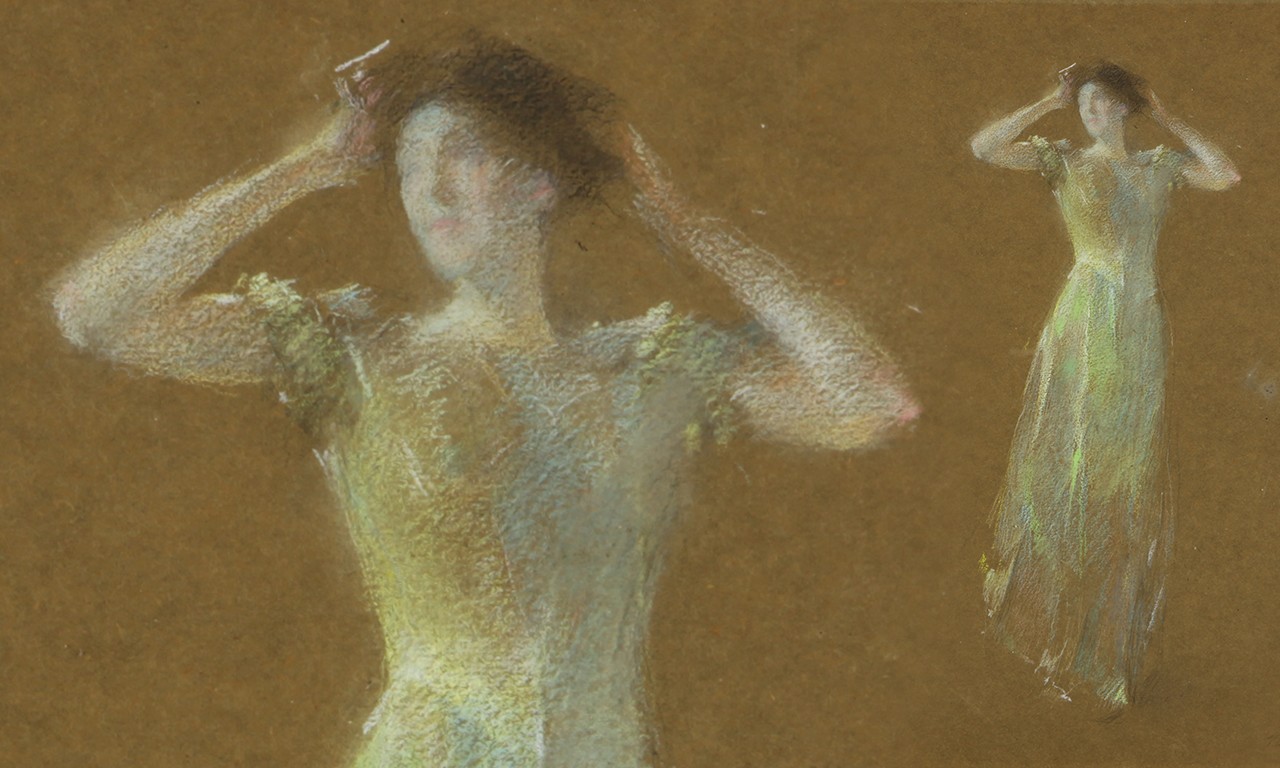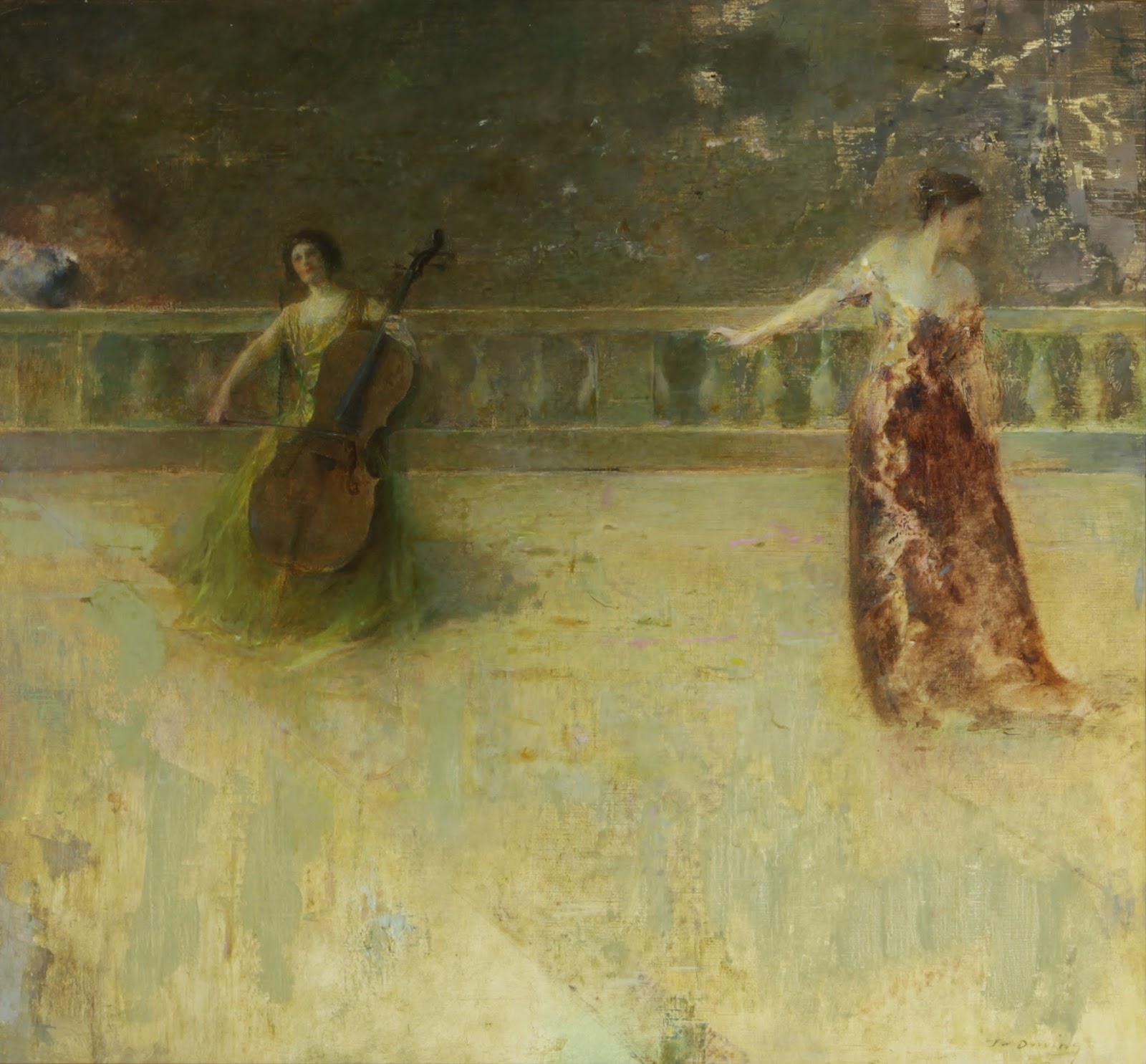 |
|
Standing Woman (pastel no. 124), 1918-1925
Thomas Wilmer Dewing (American, 1851-1938)
Pastel on brown paper; 15 x 12 in.
F7724
Martha C. Stevens Memorial Art Collection
|
Odd Thomas
Thomas Wilmer Dewing (1851-1938) was an American Gilded Age painter active in the late 19th and early 20thCenturies. He was an important member of the Tonalist movement, which used muted, natural tones to arouse a scene’s mood rather than capture the fleeting impression of it through color, as Impressionism did. Tonalism never triumphed over the immensely popular Impressionism, but it did manage to be beautiful in a brooding, nostalgic, and sometimes even haunting way. Certainly, this was a triumph of Dewing. The women he depicts are pastel idealizations of women pressed ever so lightly into the brown paper of their support; faces are blurred to abstraction; colors ranging from muted to neutral give the elegant phantoms ethereal airs. Fragmented, incomplete, his pastel drawings appear to call upon memories he cannot quite remember.
 |
|
Symphony in White, No. 1: The White Girl, 1861–62
James Abbott McNeill Whistler (American, 1834-1903)
Oil on canvas; 84.5 in × 42.5 in
National Gallery of Art, Washington, D.C.
|
A Doll’s House
Dewing’s influences came from within and outside of Tonalism. In particular, two painters stand out. The first of these is Albert Moore (English, 1841-1893), a painter famous for depicting women in various states of repose, thrown into the context of classical Grecian surroundings. These women were often cloaked in the same whites, yellows, and greens that Dewing would later use. The primary differences between the two lie in Moore’s naturalistic depictions, and the grounded, albeit anachronistic backgrounds. James Abbott McNeill Whistler (American, 1834-1903), the second major influence, was one of the fathers of Tonalism. Dewing and Whistler shared too many features to be coincidental, including a background in music which both found ways of incorporating into their artwork. For Whistler, this meant the use of color as notes. He reduced his painting’s subjects to mannequins modelling palettes. Later in life he actively wove this thematic thread through his early work, renaming paintings with titles such as Nocturne in Black and Gold: The Falling Rocket, and Symphony in White, No. 1: The White Girl. These two paintings are not evoked casually. In many ways Dewing’s works became a synthesis of Nocturne’s tonal rigidity and abstractionism and Symphony’s subject matter and treatment of subject. Dewing delves ever further into the worst accusations that have been levelled at Whistler, that for him his sitters were nothing more than dolls.
 |
|
The Dance—Twilight, c. 1890
Thomas Wilmer Dewing (American, 1851-1938)
Oil on canvas; 22 x 24 in.
F7699
Martha C. Stevens Memorial Art Collection
|
Speaking Through a Medium
Pastels were originally made and used in Northern Italy in the 16th Century, but it was not until the last part of the 19thCentury that they would experience their golden age. Following contemporary greats like Edgar Degas, Auguste Renoir, and Whistler, Dewing began using pastels in 1892. He found in it the perfect medium for capturing the dreamlike arrangements he had once struggled to create with oils, and after 1918 he almost exclusively used pastels. With it commonly depicted elegant women appeared as never seen before, in dialogue with their canvases, each painstakingly rendered stroke juxtaposed against the brown paper’s texture and color as if their very creation was a matter of some great effort. Furthermore, Dewing had always relied on a limited palette, but with the high contrast of his brown paper canvas, he now found he could rely almost exclusively on whites and the range of colors so intrinsic to his medium they were themselves called pastels. “[A] flush of rose to him mean[t] as much as crimson to another.”
 |
|
Thomas Wilmer Dewing, c. 1880.
The Freer Gallery of Art,
Smithsonian Institution, Washington D.C.
|
We All Float Down Here
Though there is no evidence that Dewing referred to his pastel drawings by anything other than the numbering seen in his drawings’ lower right corners, many of the titles assigned to his pastels have been variations of Woman Standing, and there is something misleading about this designation. Even in the drawings where the women do not disappear into nothingness, as the unknown subject of this pastel does, they still tend to float—unshored—in their empty backgrounds. On the surface Dewing was handsome, vigorous, and sociable; but his work betrays a darker facet of his character. “Vulgarity,” he once said, “is in every human being and will out. With some it shows in their acts or talk and in some in their work. It would seem wiser to have it come out in some less permanent way than work.”
Text and images may be under copyright. Please contact Collection Department for permission to use. Information subject to change upon further research.





Comments